Tempting Sweets Tour in downtown Miyazaki

Nestled in the heart of Miyazaki City, a tapestry of confectionery treasures awaits—a collection of beloved shops cherished by locals for generations. Join us as we uncover the sweet secrets of downtown Miyazaki, showcasing their timeless treats and delights!
Aji no Kuraya (味のくらや)

Since its establishment in 1955, Aji no Kuraya (味のくらや) has been dedicated to crafting Miyazaki’s local sweets. Cherished as a symbol of “Miyazaki’s grandma’s flavor,” it has been beloved by the people of Miyazaki for many years.
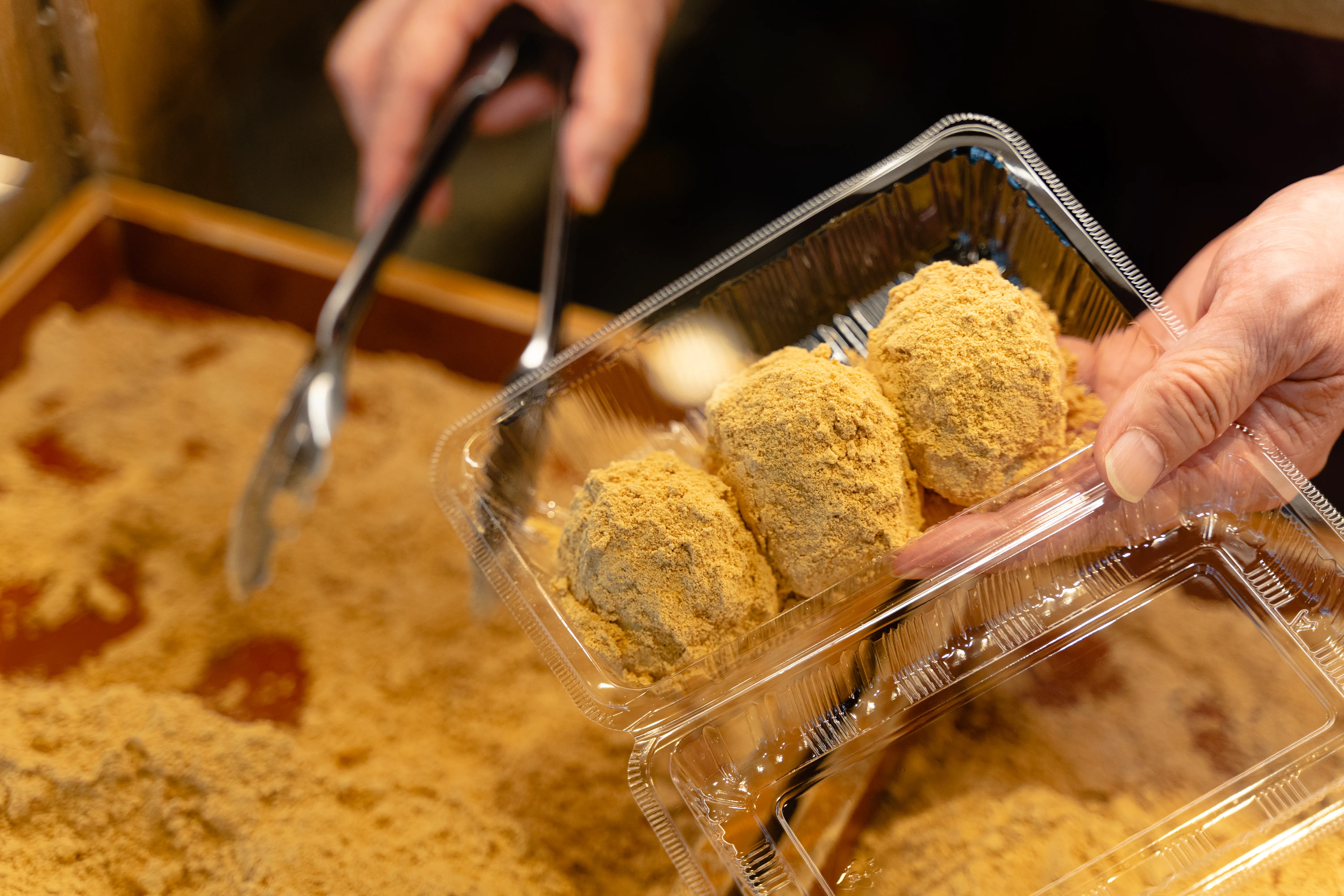
The shop’s story began with the current president’s grandmother, who had a deep passion for making sweets. Her local confections were sold to supermarkets by her grandfather. Driven by the desire to “preserve the beloved taste of our grandmother’s local sweets for future generations,” this dedication has been passed down through the second and third generations, continuing to thrive.
Nerikuri (ねりくり) is a traditional Miyazaki sweets, deriving its name from the local dialect meaning “pound and mix.” It features a blend of boiled rice cakes and steamed sweet potatoes, shaped into balls and coated with roasted soybean flour (kinako), a familiar sight in supermarkets and beloved by locals.
Karaimo Dango (からいも団子) originated when the second-generation president of Ajino Kuraya stuffed sweet bean paste into the nerikuri dough for a food exhibition outside of Miyazaki. Since then, it has garnered enduring popularity, becoming a customer cherished favorite. With 70% of the ingredients being sweet potatoes, it doesn’t harden like regular mochi even when stored in the refrigerator, making it ideal to chill and enjoy during hot seasons. It also complements iced or hot green tea exceptionally well.
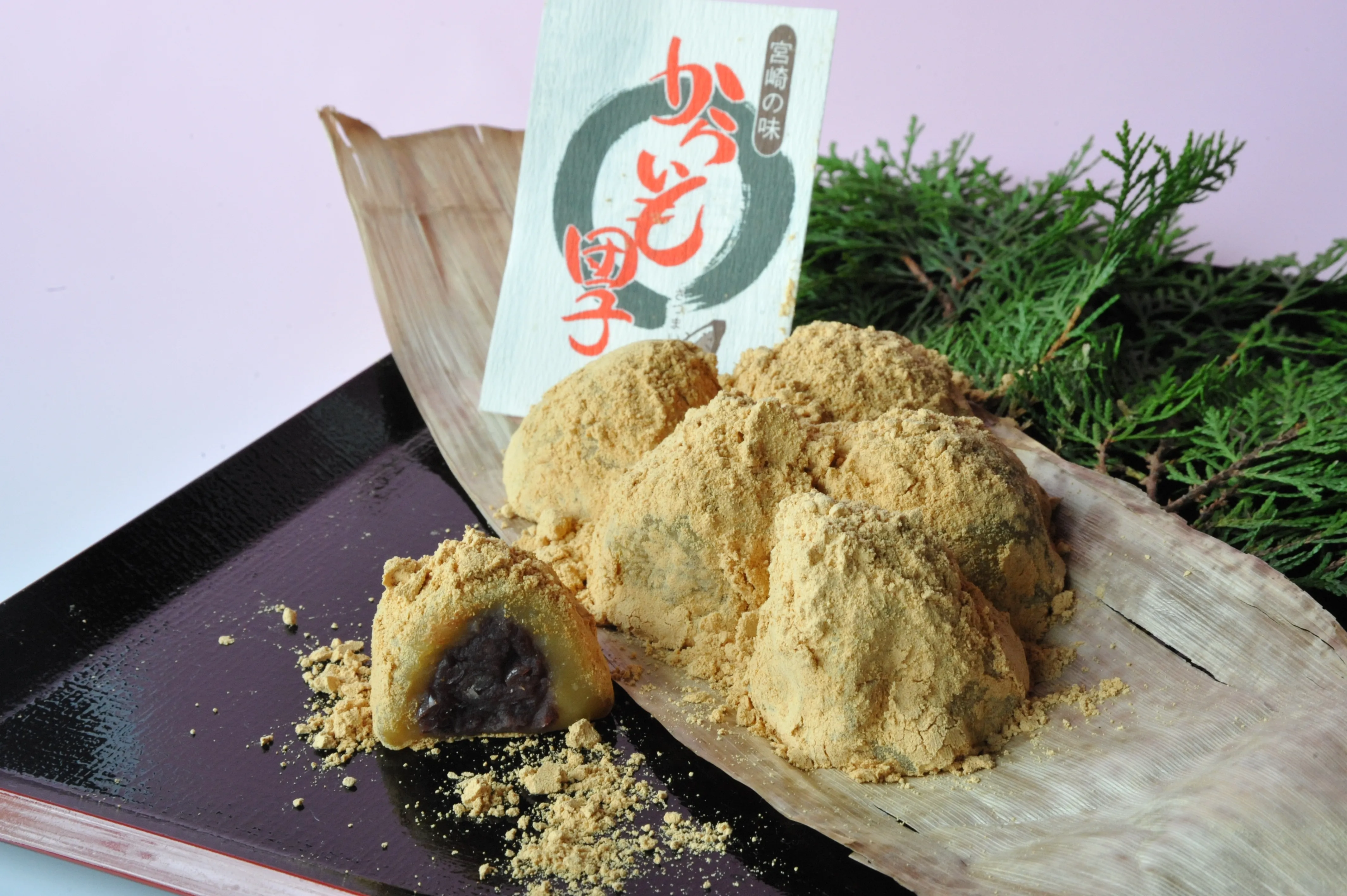
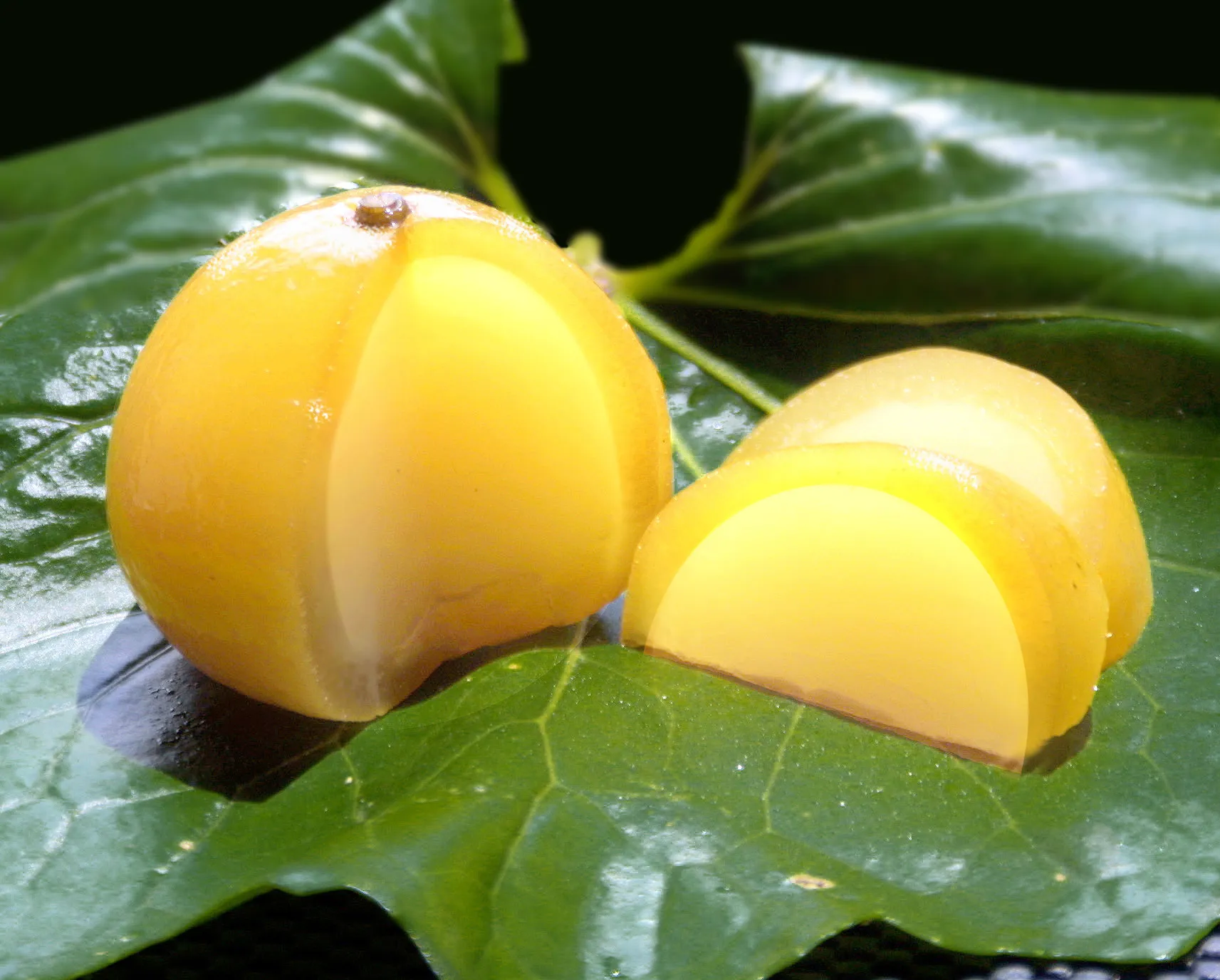
Another customer’s favorite is the “Hyuganatsu Youkan Kimusume (日向夏ようかん 黄娘),” made with the citrus fruit native to Miyazaki, Hyuganatsu (日向夏). To create this delicacy, a small hole is made in the top and bottom of the fruit, and the contents are scooped out. The entire peel is then simmered and soaked in syrup for four days. The hollowed peel is filled with white bean paste mixed with Hyuganatsu juice and agar and then sealed.
The texture is surprisingly smooth and offers refined sweetness, complemented by the slight bitterness and acidity of Hyuganatsu. It’s vibrant and charming, making it an ideal choice for gifts and souvenirs.
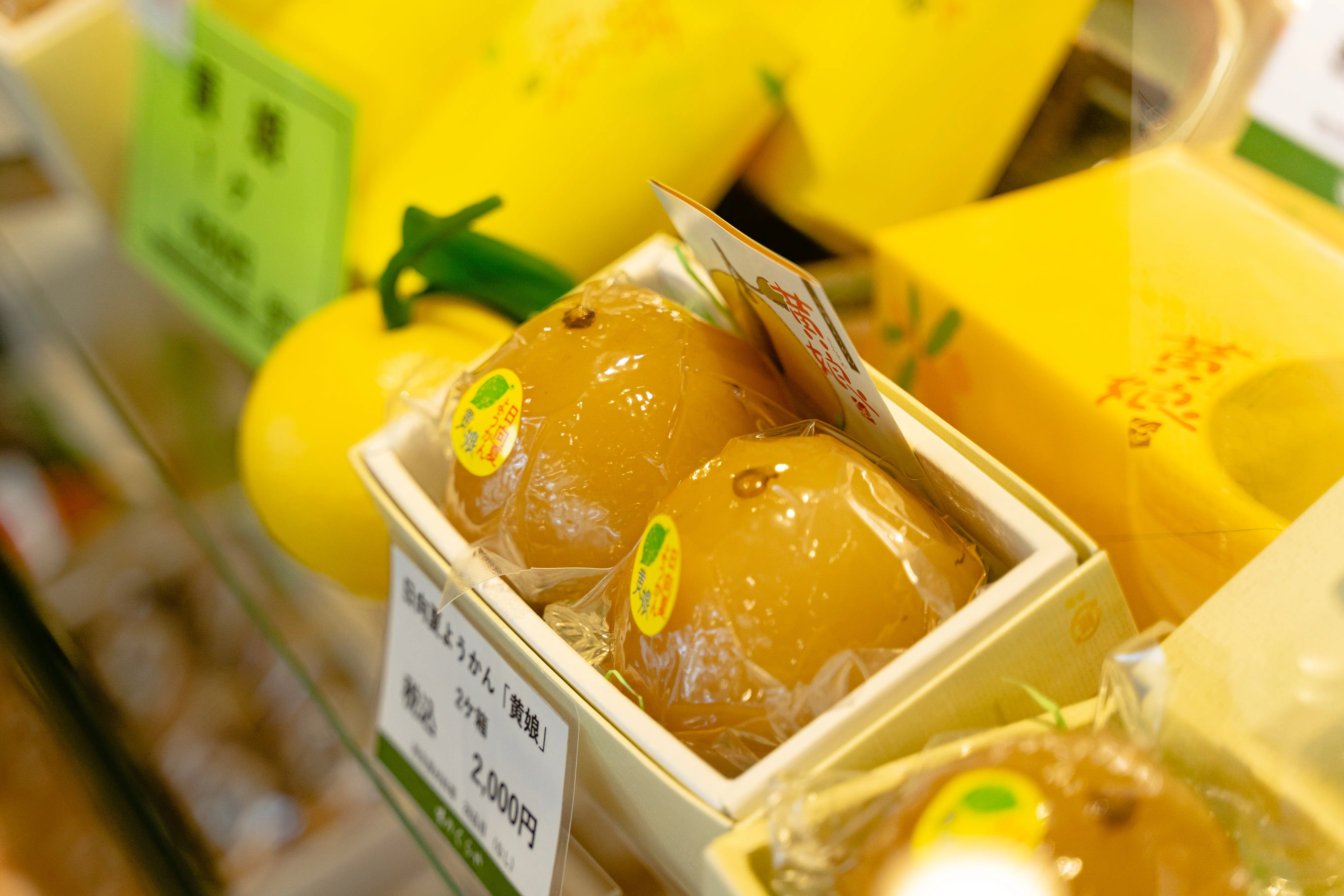
At Aji no Kuraya, they also offer a variety of nostalgic Miyazaki local sweets, including “Fukafuka,” a steamed cake from southern Kyushu known for its rich brown sugar flavor and fluffy, springy texture. Additionally, they make original cheese buns using the same Fukafuka dough, along with many other traditional confections that bring back fond memories of Miyazaki.
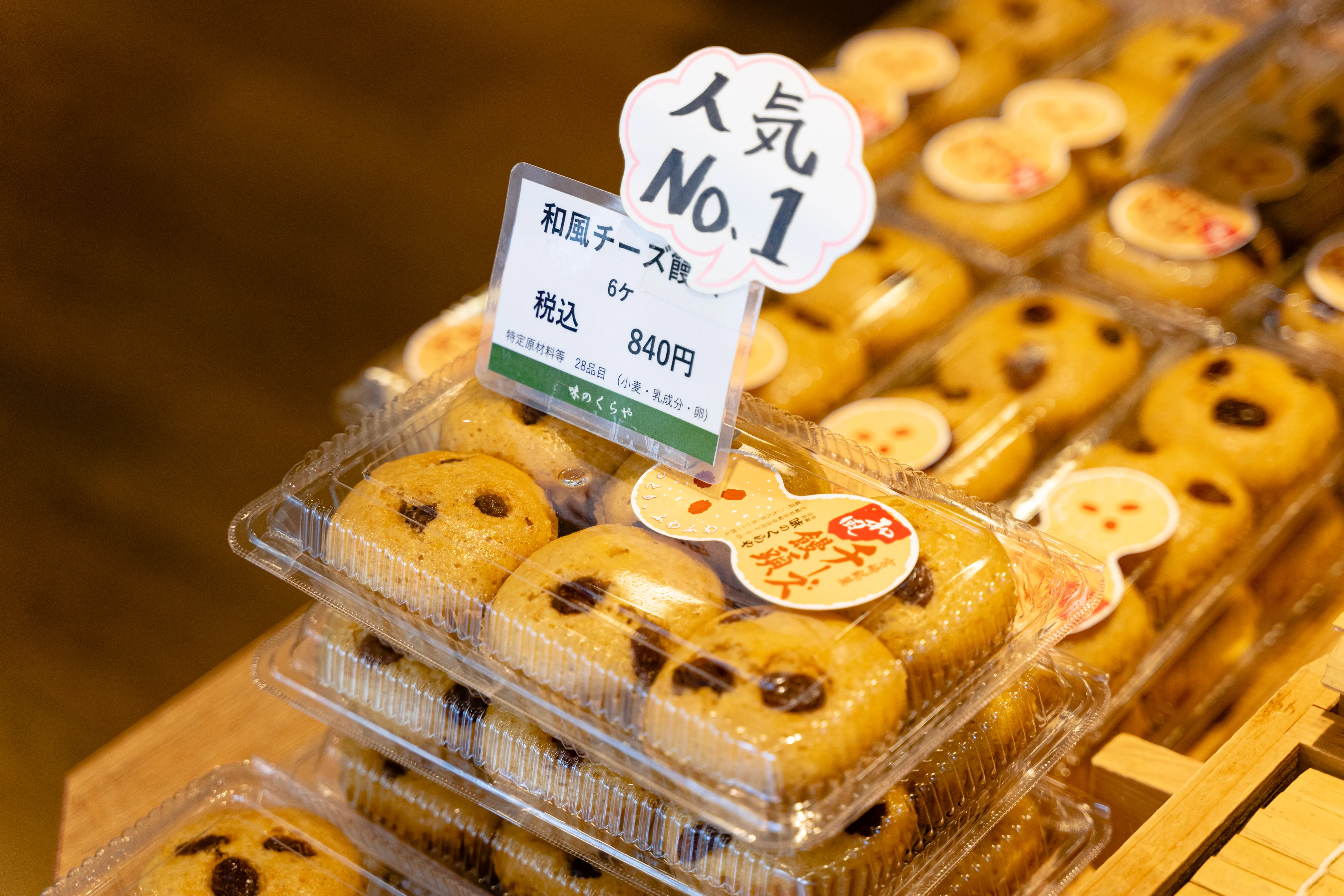
Experience the nostalgic flavors of Miyazaki’s traditional local sweets that are deeply rooted in the lives of its people.
Locations:
Miyazaki Airport Branch (2nd Floor), Amu Plaza Miyazaki Branch, and Miyazaki Yamagata-ya Branch (Main Building B1).
Payment Methods:
Cash, credit cards, QR code payments, and electronic money.
For more information, visit their websites below.
Officaial Website: https://www.ajinokuraya.co.jp/
Online Shop: https://ajinokuraya.shop-pro.jp/
Okashi no Hidaka (お菓子の日高)
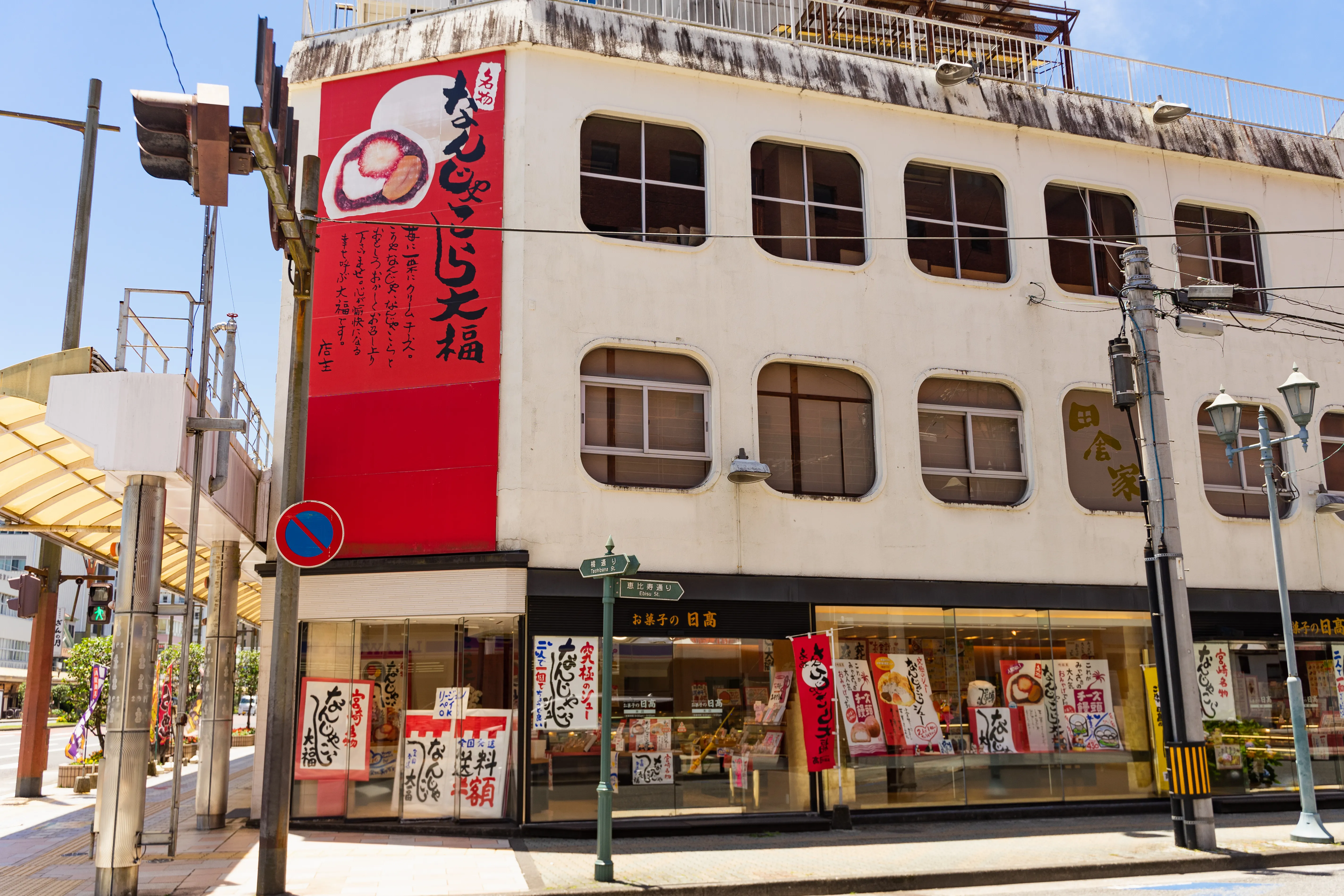
In the heart of Miyazaki City, if you head south along Tachibana Street from the major intersection of Takachiho Avenue and Tachibana Street, you’ll encounter a large, vibrant red sign featuring handwritten characters and a picture of a giant daifuku. This signifies the main store of Okashi no Hidaka (お菓子の日高).
After World War II, the previous generation returned from the battlefield, resigned from their government job and decided to start a business. They called confectionery artisans to their factory and diligently learned the fundamentals of confectionery making. Their goal was to create confections that could be proudly called “local specialty sweets”. Gradually, they shifted from wholesale to in-house production and direct sales to achieve this vision.
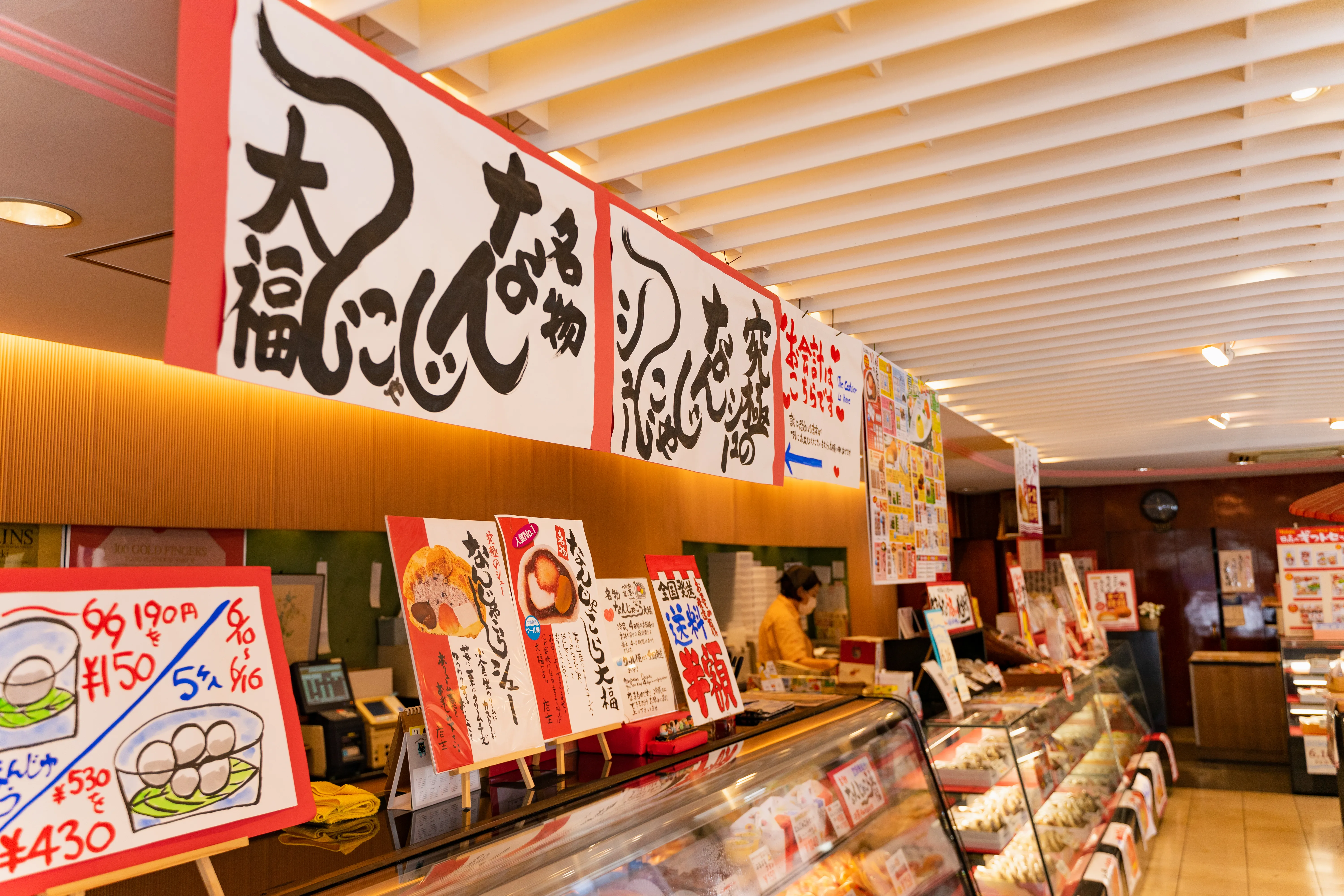
When the first store opened, Tachibana Street was bustling with diverse businesses and lively customers. However, over time, as housing estates formed and chain stores emerged, many shops and residences withdrew.
Despite these changes, they persevered through economic shifts to continue crafting confections. Today, Okashi no Hidaka has become a well-known confectionery shop recognized by every resident of Miyazaki.
When it comes to Okashi no Hidaka’s signature menu item, it’s undoubtedly the “Nanjakora (What the hell is this?) Daifuku,” prominently displayed on their signboard.
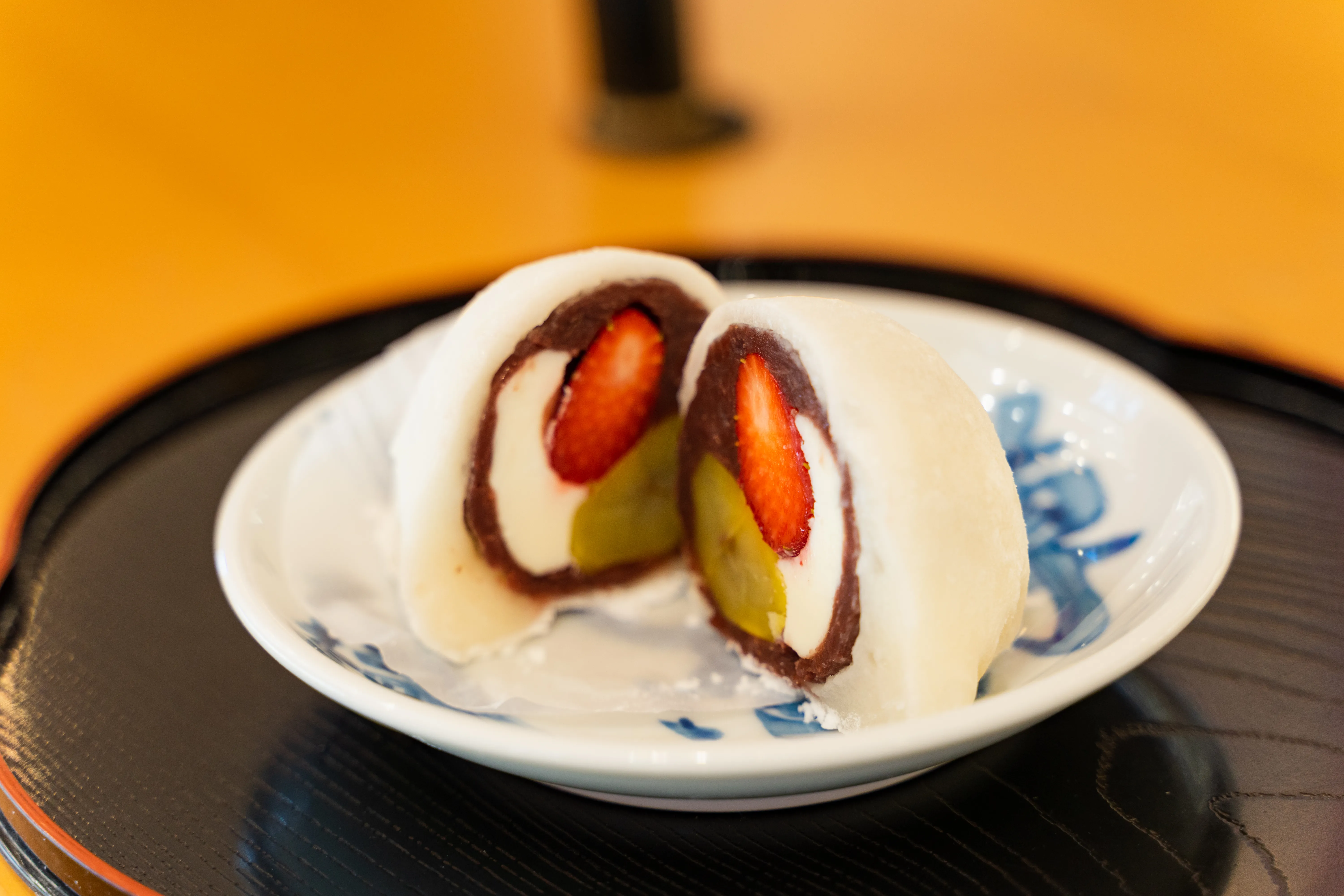
The history of the “Nanjakora Daifuku” is quite fascinating. In 1987, it was created during the Daifuku Festival organized by the second-generation president, where it was first introduced for sale.
During that time, the president and employees brainstormed twenty different types of daifuku to liven up the festival. Among various ideas like elongated daifuku, banana-filled daifuku, corn-filled daifuku, and even daifuku with sausages, they came up with the idea of combining strawberry, chestnut, and cheese in a single daifuku.
After making it, when the president’s close friend, a passionate sweets enthusiast, tasted it, surprised by the different fillings inside, and exclaimed, “What the hell is this?” Thus, the name “Nanjakora” was born. Afterward, when it was sold as the main daifuku at the festival, it received high praise from local customers and became firmly established among the people of Miyazaki.
Other popular original products include the “Nanjakora Cream Puff (なんじゃこらシュー),” a giant cream puff filled with strawberry, chestnut, cream cheese, and sweet red bean paste whipped cream, and the “Bata Dora (バタどら),” a dorayaki with a deliciously salty butter filling. These unique treats captivate customers and keep them coming back for more.
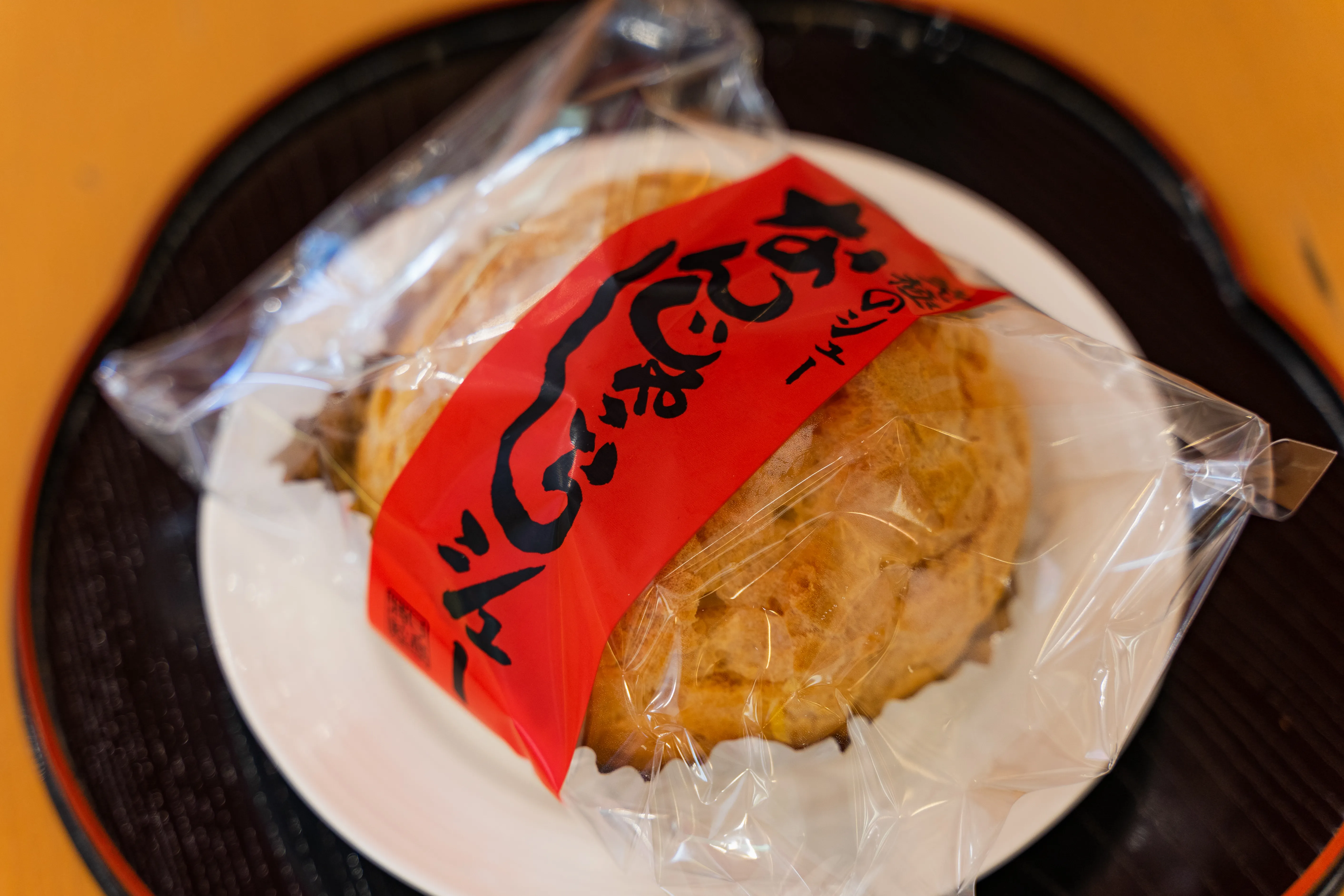
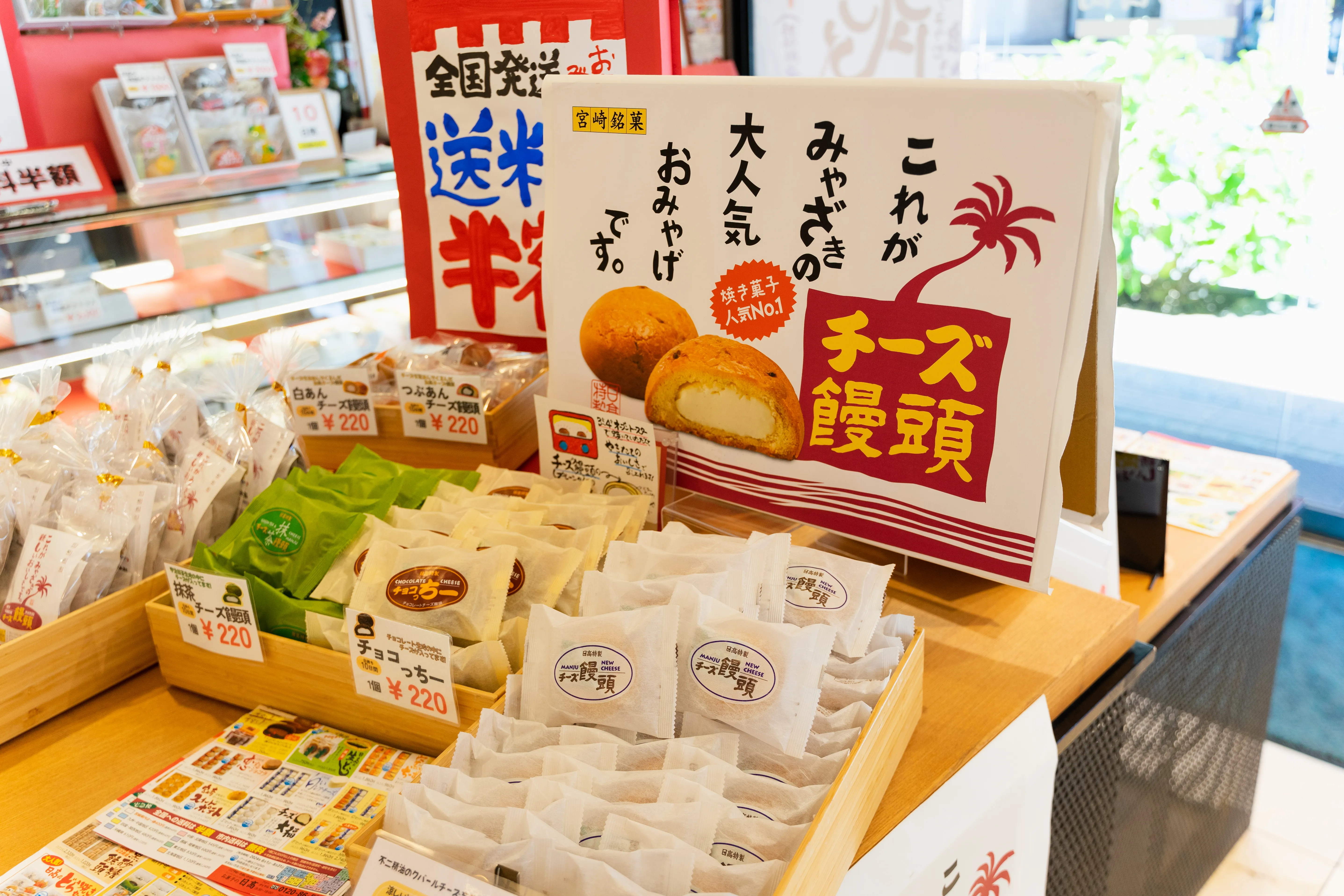
Locations:
Miyazaki Main Branch, Miyazaki Station Branch, and five more in Miyazaki City.
Payment Methods: Cash, credit cards, QR code payments, and IC cards
For more information, visit their websites below.
Official Website: http://hidaka.p1.bindsite.jp/index.html
Online Shop: https://okashinohidaka.com/
Mizunoya (水野屋)
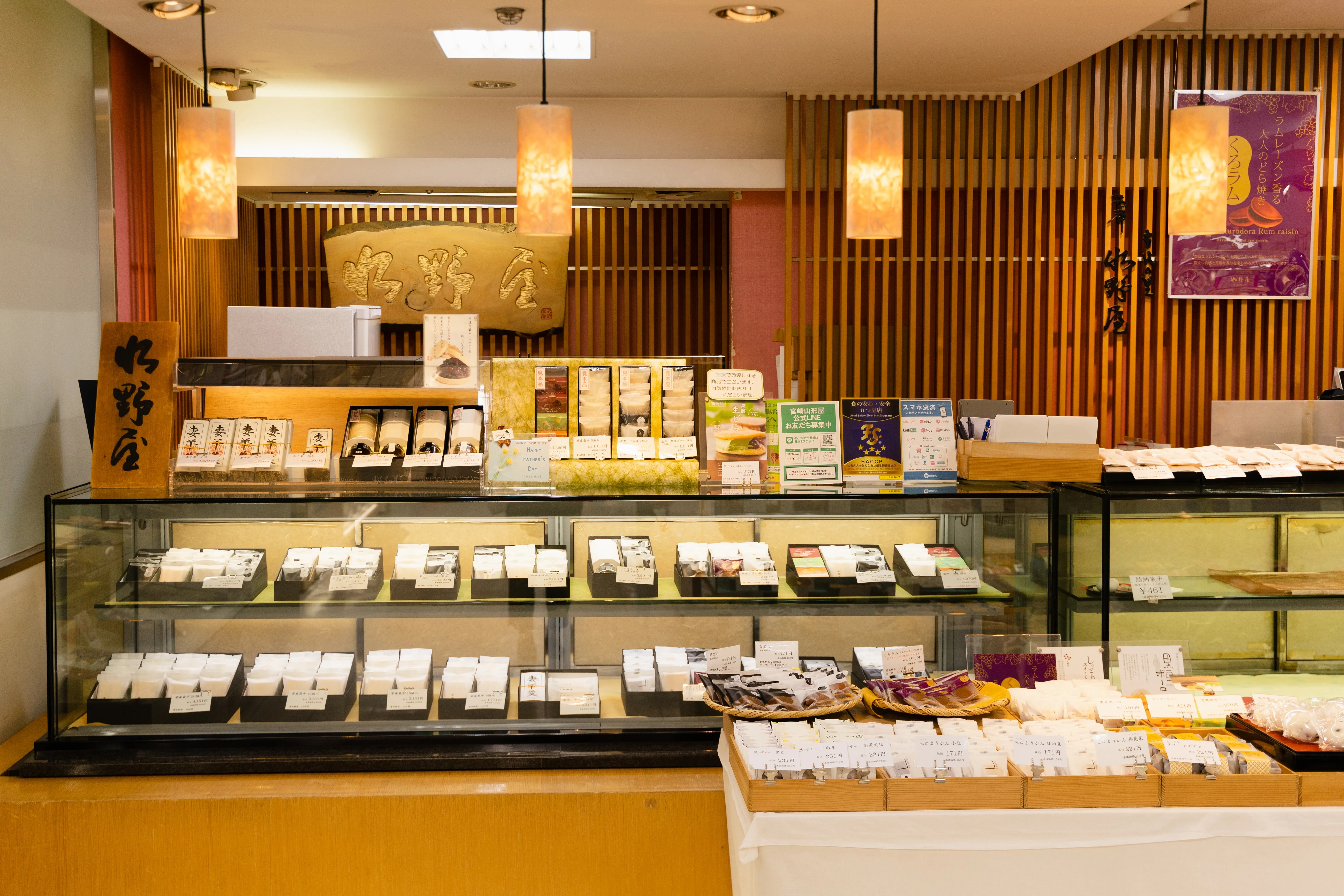
Mizunoya (水野屋) is one of Miyazaki’s oldest wagashi (traditional Japanese sweets) specialty shops, boasting over a hundred years.
Since its founding in 1913, Mizunoya has upheld the strong belief inherited from previous generations to use only genuine ingredients. This commitment continues to shape their offerings of various exquisite wagashi throughout the seasons, including their flagship product, monaka.
Monaka (最中) is a traditional Japanese sweet consisting of two thin, crisp wafers made from mochi filled with anko, sweetened red bean paste.
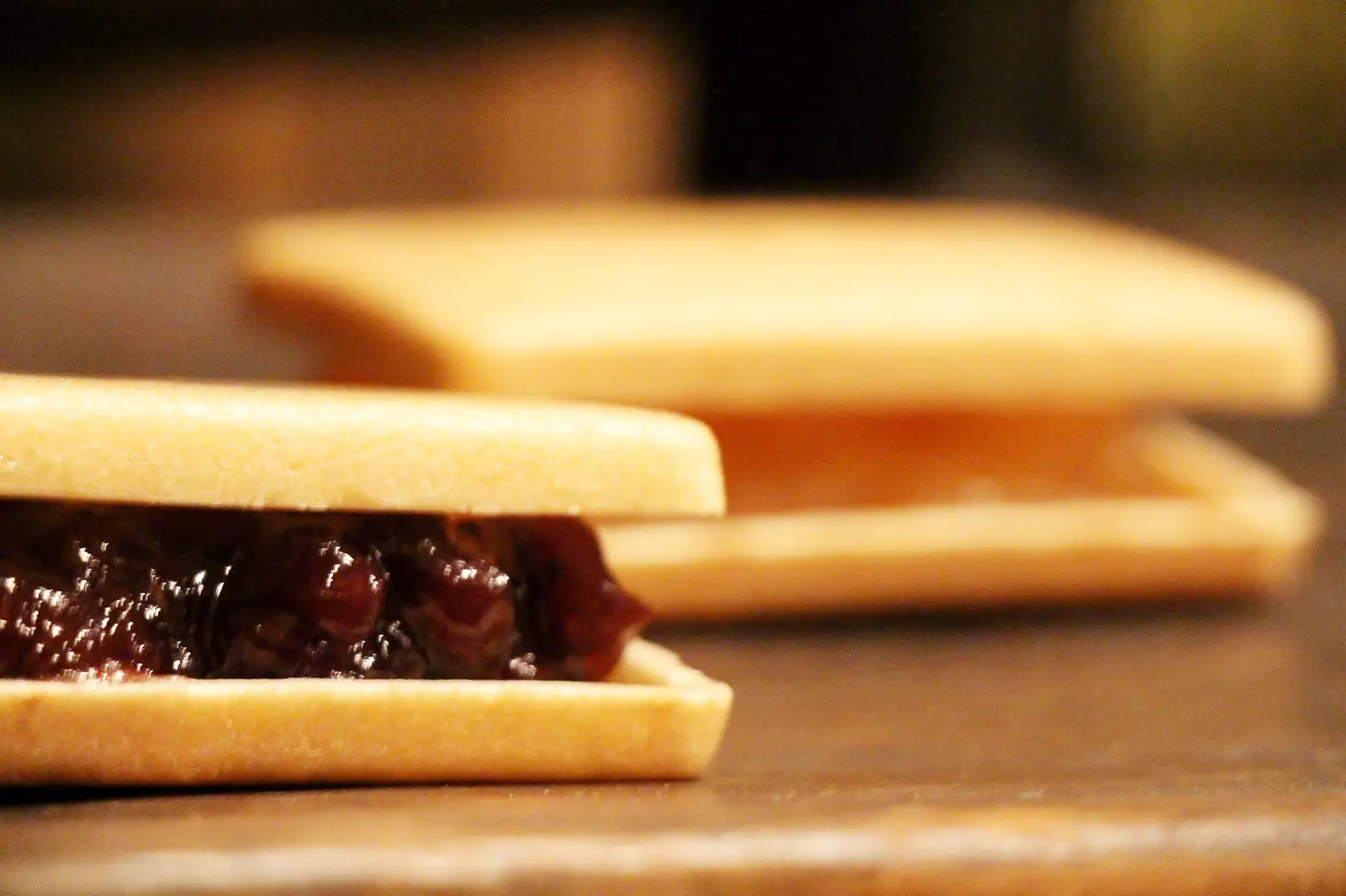
The enduring popularity of Mizunoya’s monaka lies in its unwavering commitment to exceptional ingredients and ongoing exploration. They meticulously source adzuki beans from Hokkaido, yet recognize that each year’s crop varies due to local climate and growing conditions. Therefore, they taste-test every batch to select the best beans for their confections.
The current president, driven by a passion for upholding tradition while embracing innovation, blends Hokkaido adzuki beans with varieties from other regions. They also experiment with different bean sizes, continually striving to enhance flavor through dedicated exploration and enthusiasm for Japanese confectionery.
There are four flavors available: classic Monaka with coarse red bean paste, smooth homemade strained red bean paste, Matcha Monaka with Kyoto matcha offering a delicate balance of bitterness and sweetness, and Yuzu Monaka featuring locally sourced yuzu from Saito City in Miyazaki, known for its refreshing citrus flavor.
At Mizunoya, various Japanese sweets, “wagashi (和菓子),” are offered throughout the year, each carefully selected to match the seasons.
“Wagashi allows you to experience the changing seasons of Japan through food. There’s a culture of enjoying each season through specific sweets that are perfect for that time of year. I hope you’ll savor them with your eyes and your palate to appreciate each season,” says Mizunoya staff member Ms.Mizuno.
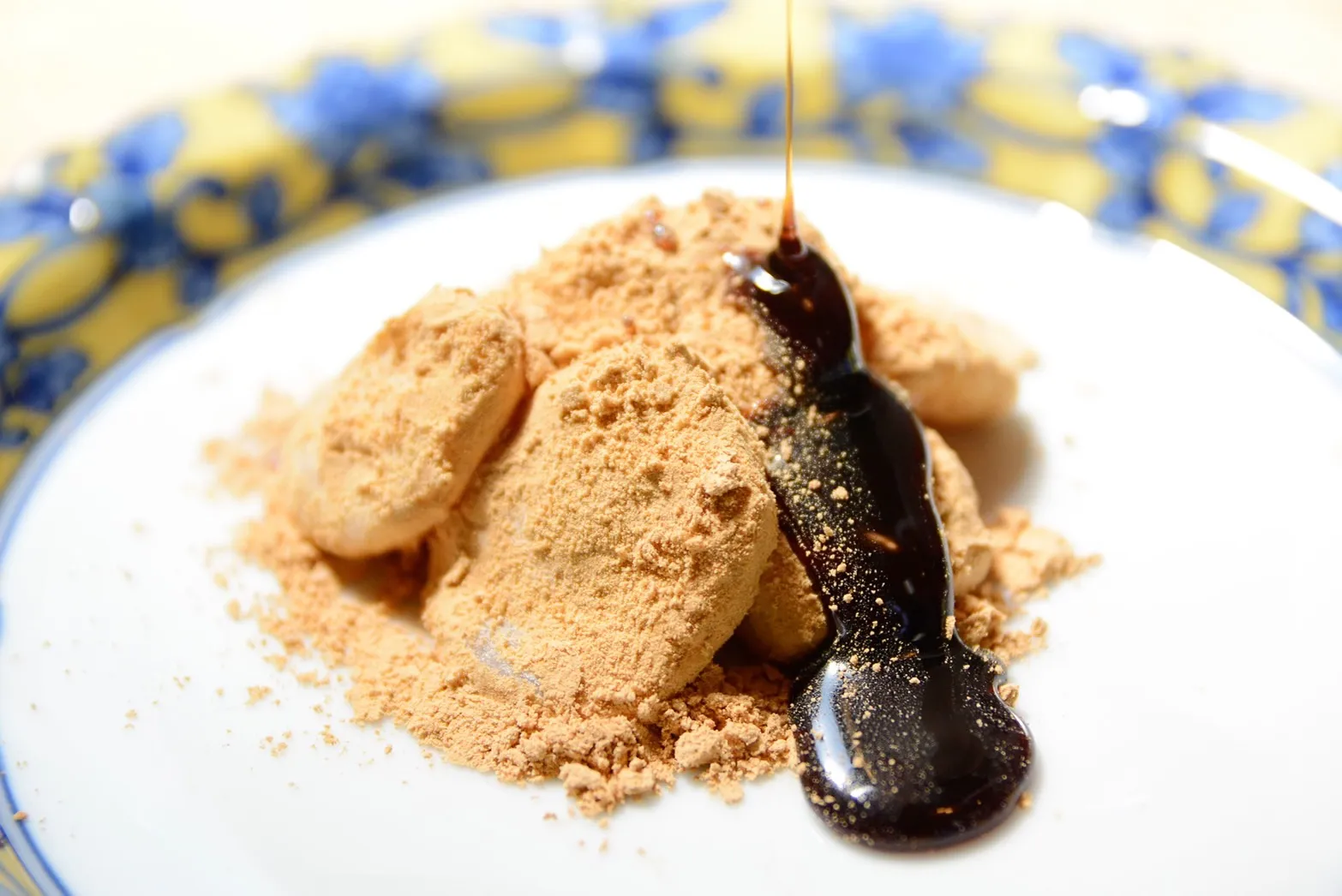
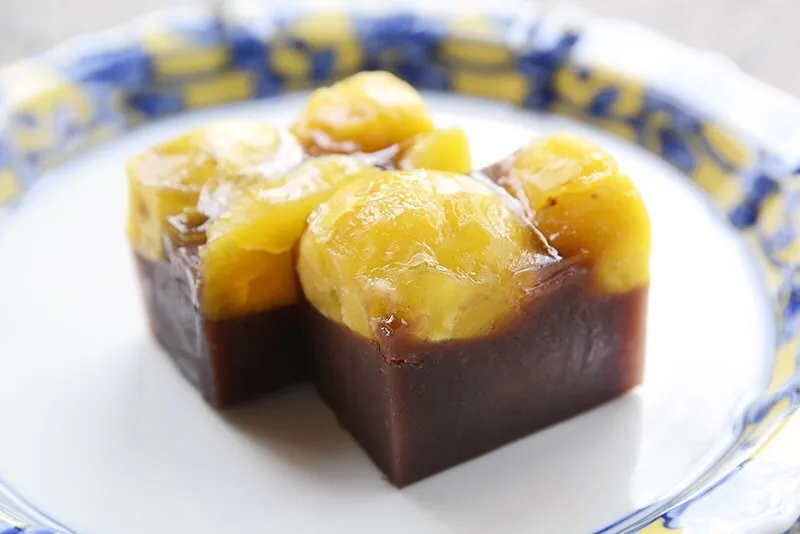
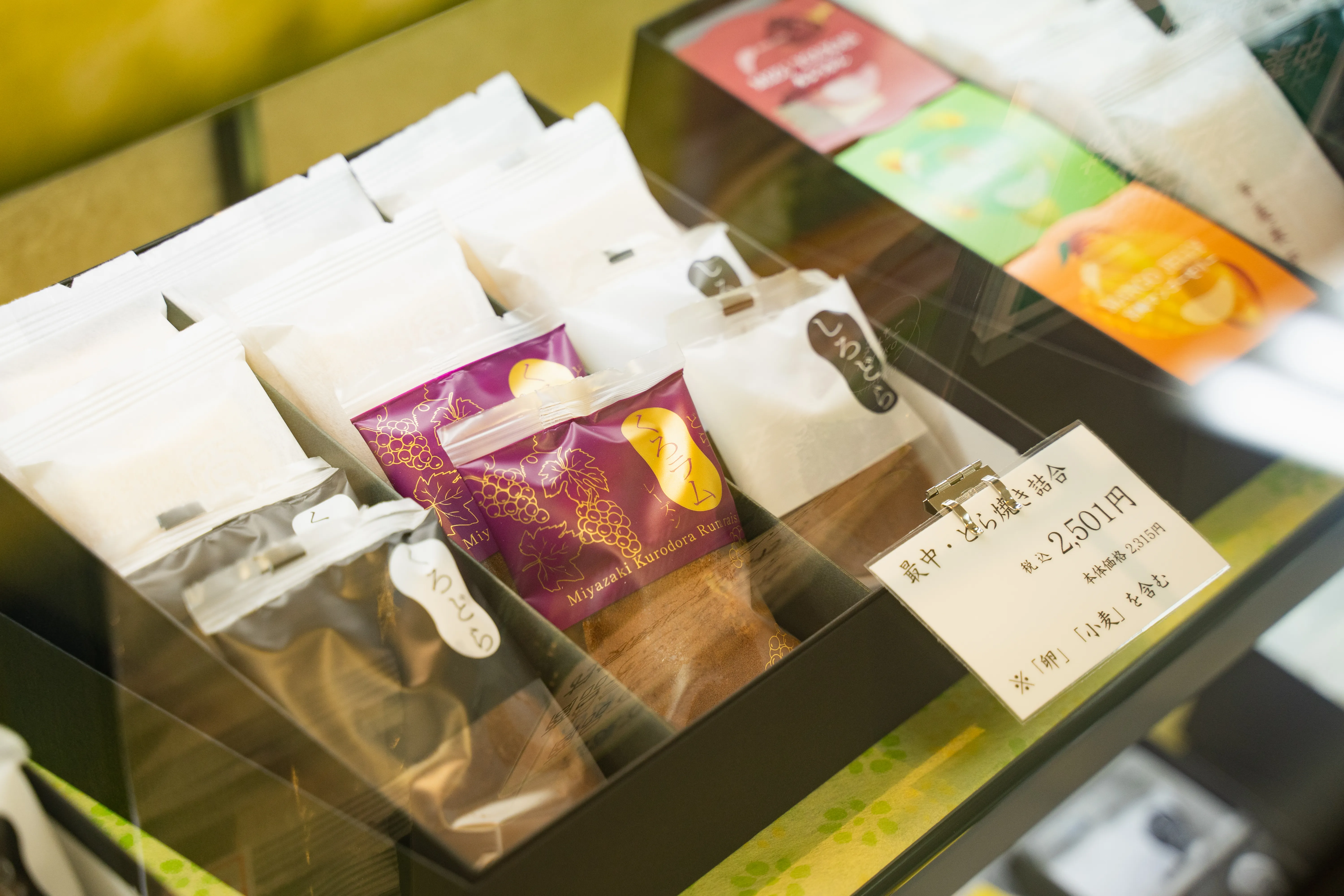
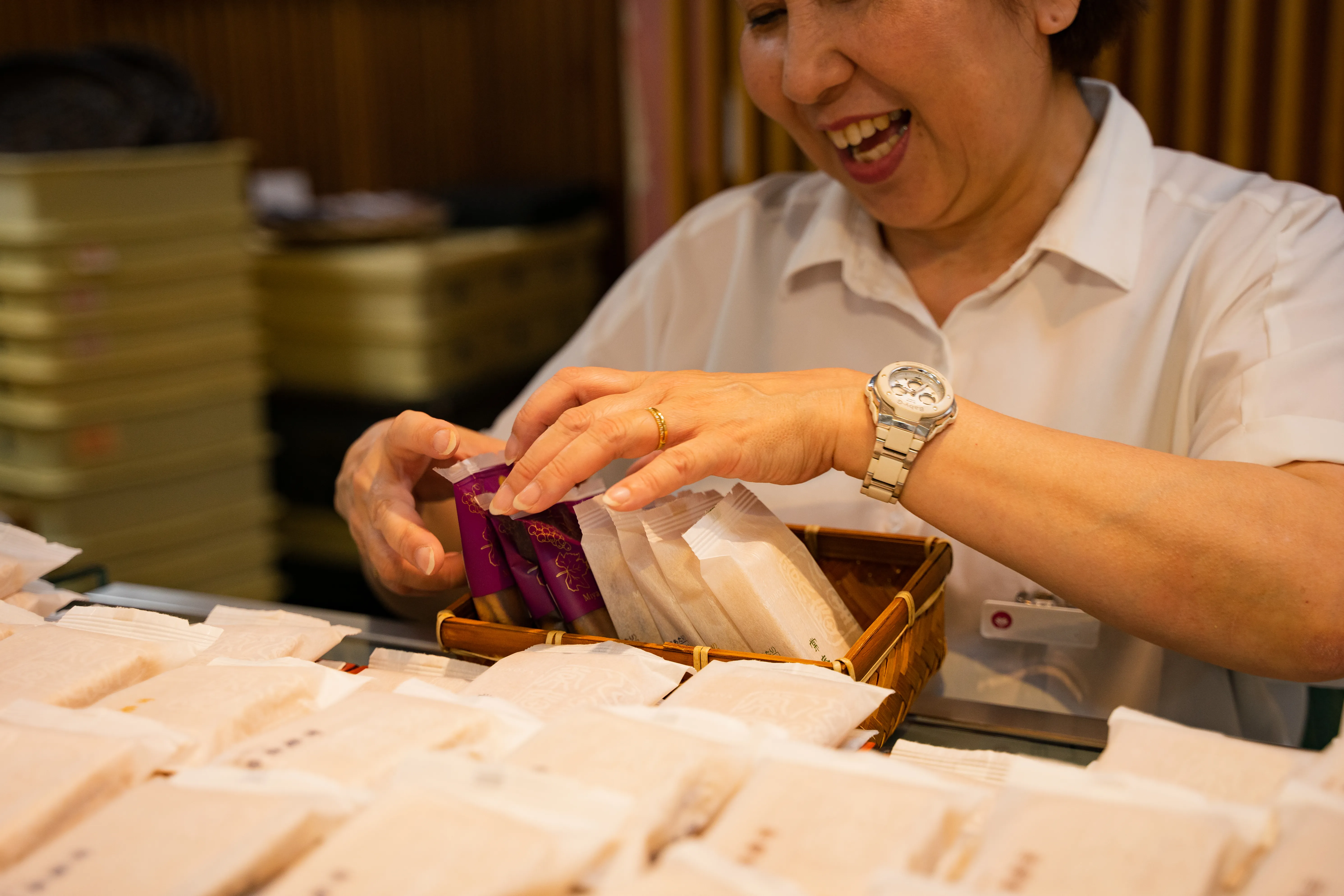
Why not try Miyazaki’s authentic Japanese sweets, which have focused on quality and taste for over a hundred years and continue to be beloved by locals?
Locations:
Miyazaki Yamakataya Branch, Jingu Branch, and Main Branch (in Saito City).
Payment Methods:
Cash, credit cards, QR code payments, and electronic money.
For more information, visit their websites below.
Online Shop: https://www.wa-mizunoya.com/
Kiriki Kagrado (桐木神楽堂)
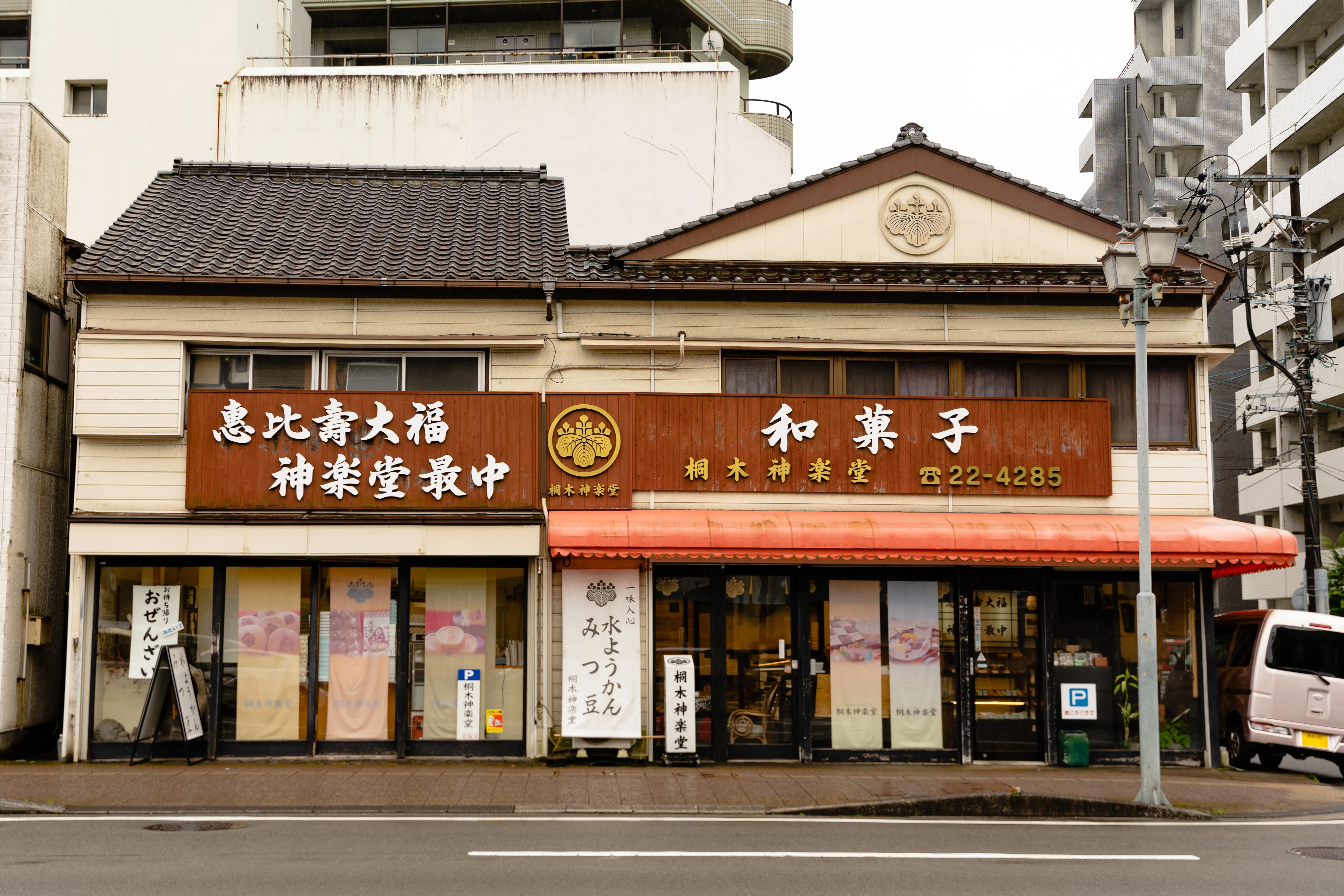
“Kiriki Kagradou’s sweets are a delight for anyone who receives them.” This renowned store, with a history spanning over ninety years, is highly trusted by the local community and enjoys a loyal customer base. Situated near the Oyodo River, it is just south of Tachibana Street.
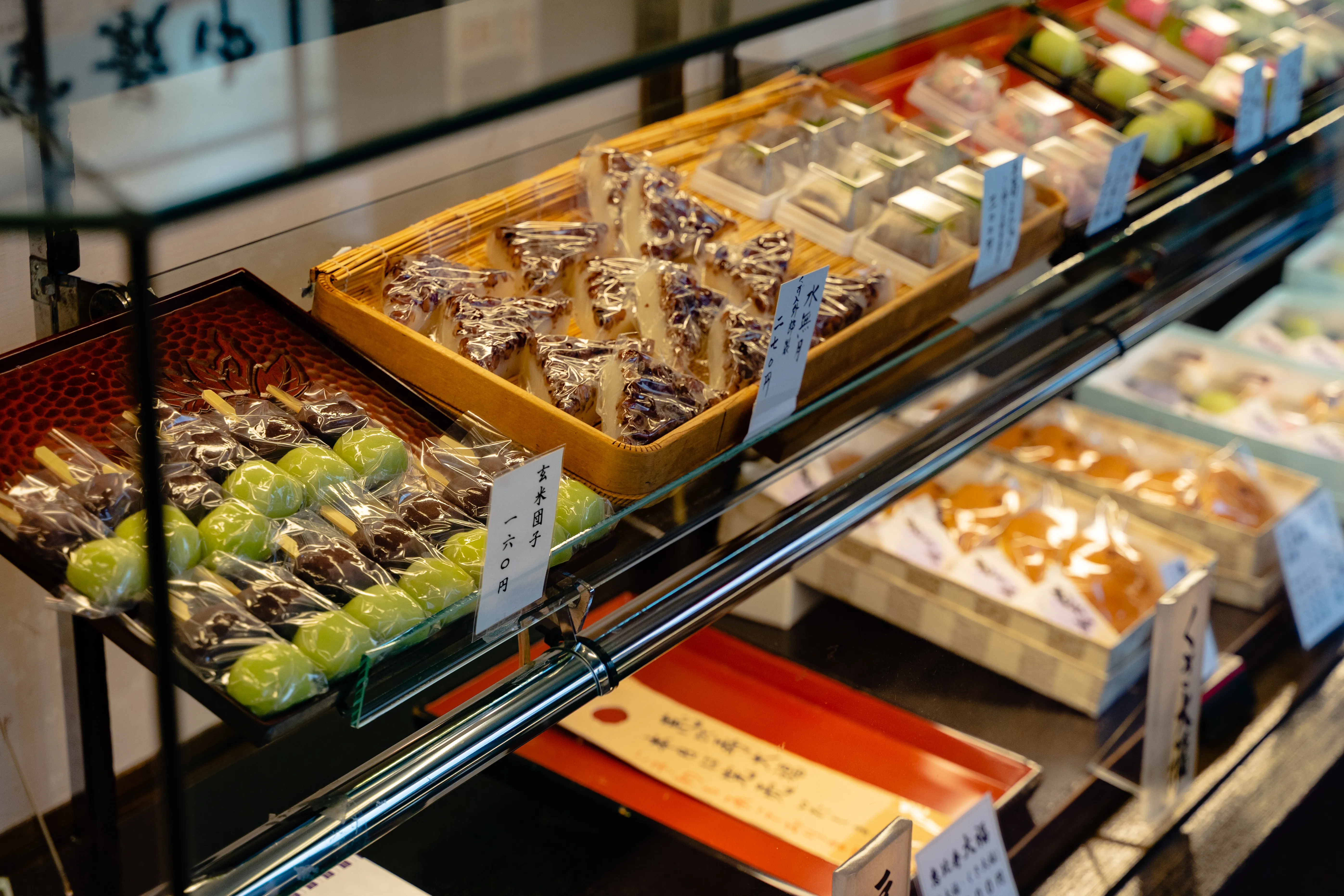
“The range of expression in wagashi is vast. For instance, if asked to express ‘a path,’ it can be done. If asked to express the subtleties of emotions like joy or sorrow, it can be achieved by meticulously changing colors, shapes, and materials,” says Mr. Daisuke Kiriki, the fourth-generation owner. The shop’s showcase is filled with a diverse array of beautiful wagashi.
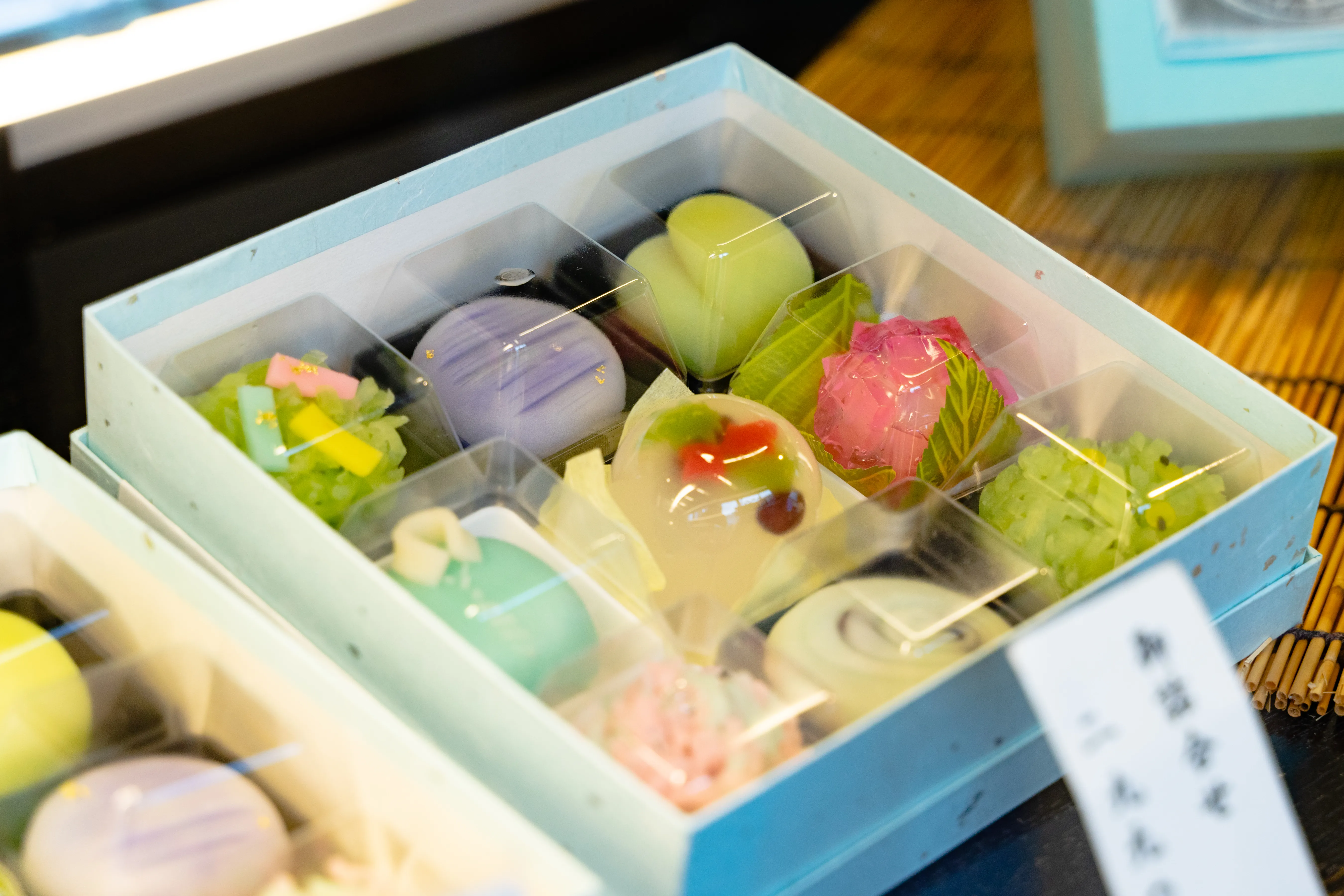
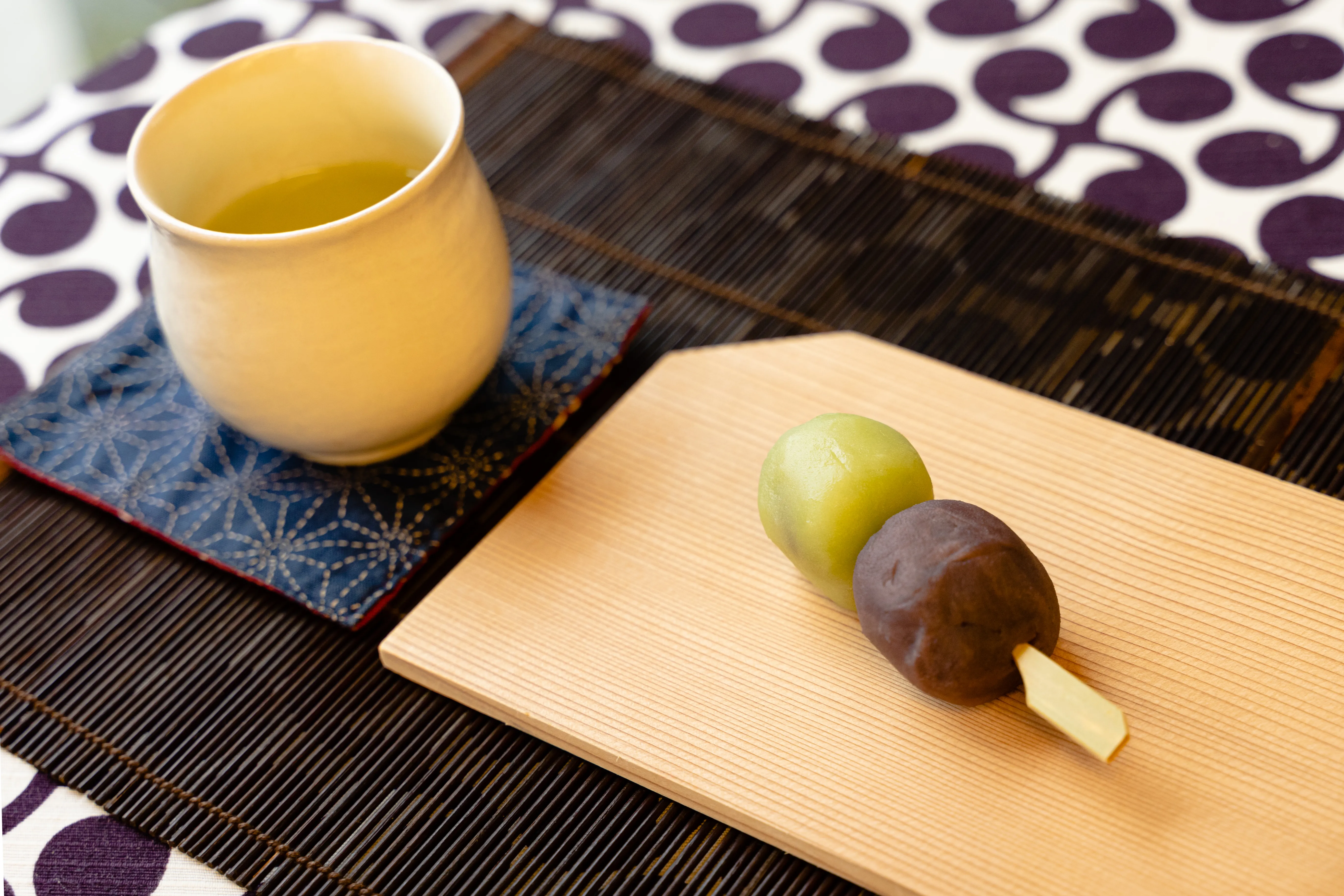
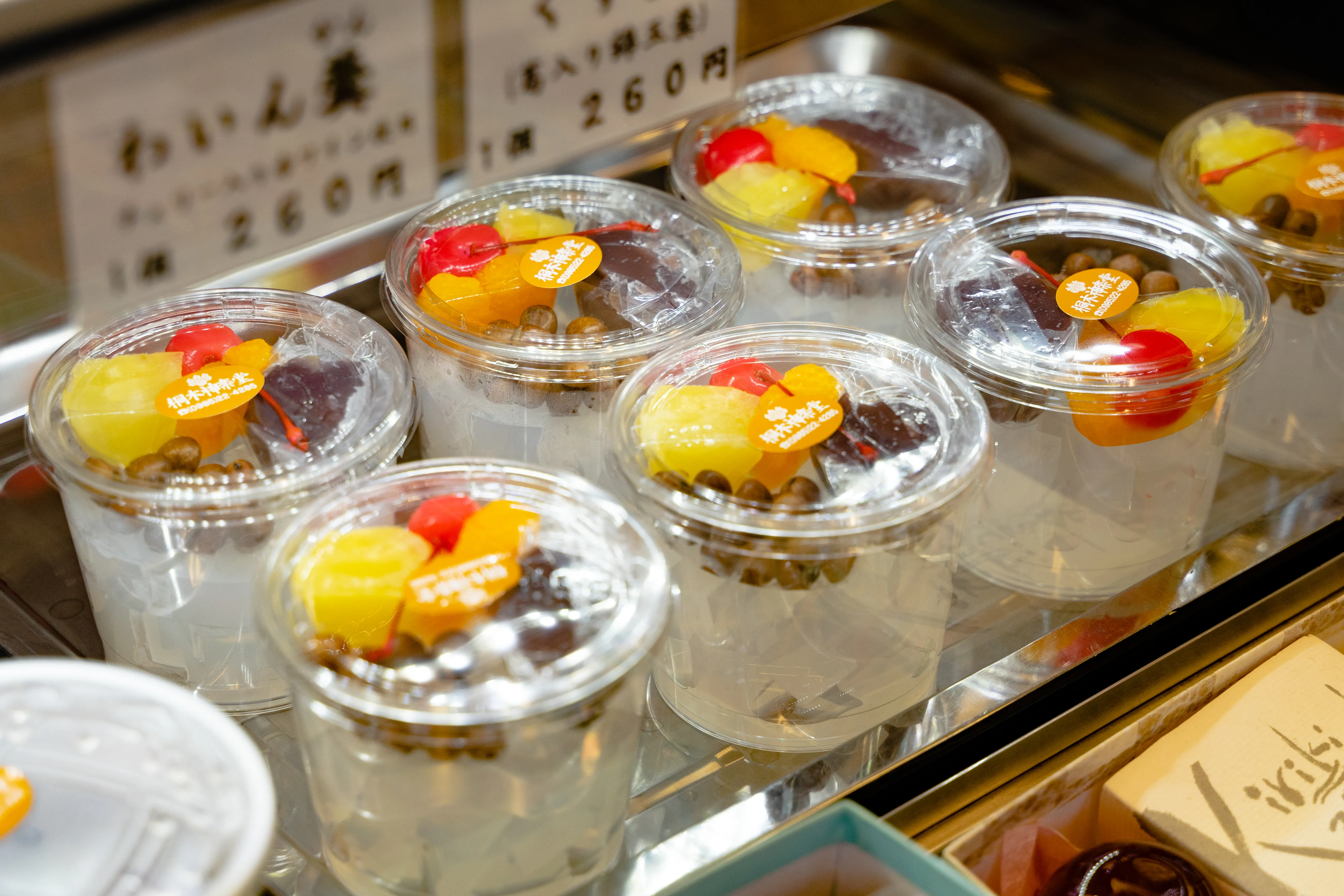
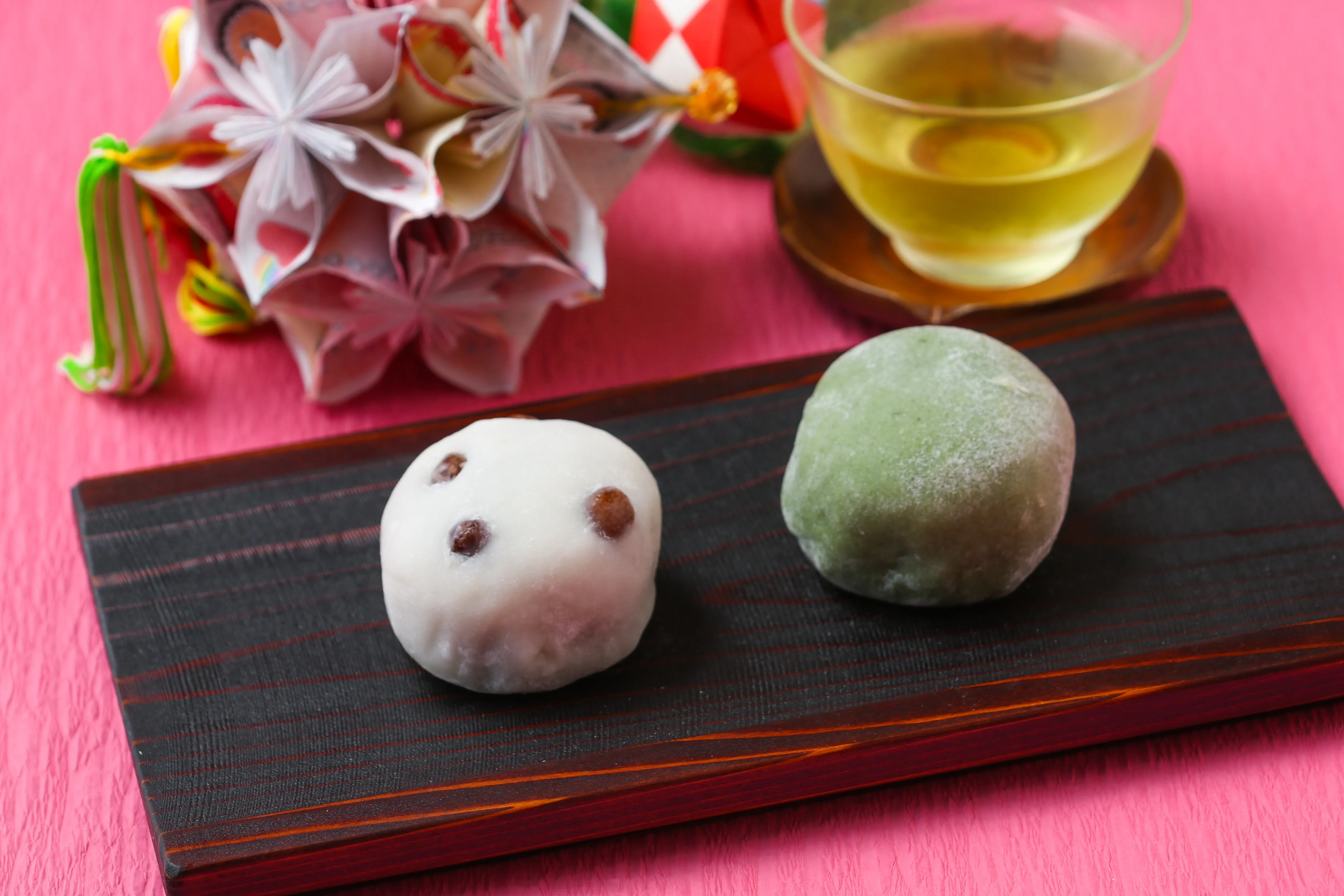
One of Kiriki Kagrado’s top-selling specialties is the “Mame Daifuku (豆大福)”. It became renowned as a must-try item that often sells out quickly. The inspiration behind its creation came during the tenure of the third-generation president when his mother expressed a desire to taste mame daifuku, a treat limited to urban shops at that time. Kiriki Kagrado pioneered the creation of mame daifuku in Miyazaki, becoming widely known and loved for this unique offering.
Mame Daifuku is made with 100% sticky rice for a rich rice flavor. Both the beans and the sweet red bean paste inside have a hint of salt, ensuring a light and enjoyable texture. Typically, daifuku uses sugar in the dough to extend its shelf life, but here, no sugar is added, preserving its chewy texture intended for same-day enjoyment. When visiting the city center of Miyazaki, be sure to try one for yourself.
If you are looking to buy a souvenir, this vibrant and charming sweets box from Kirikii Kagrado would be the best choice.
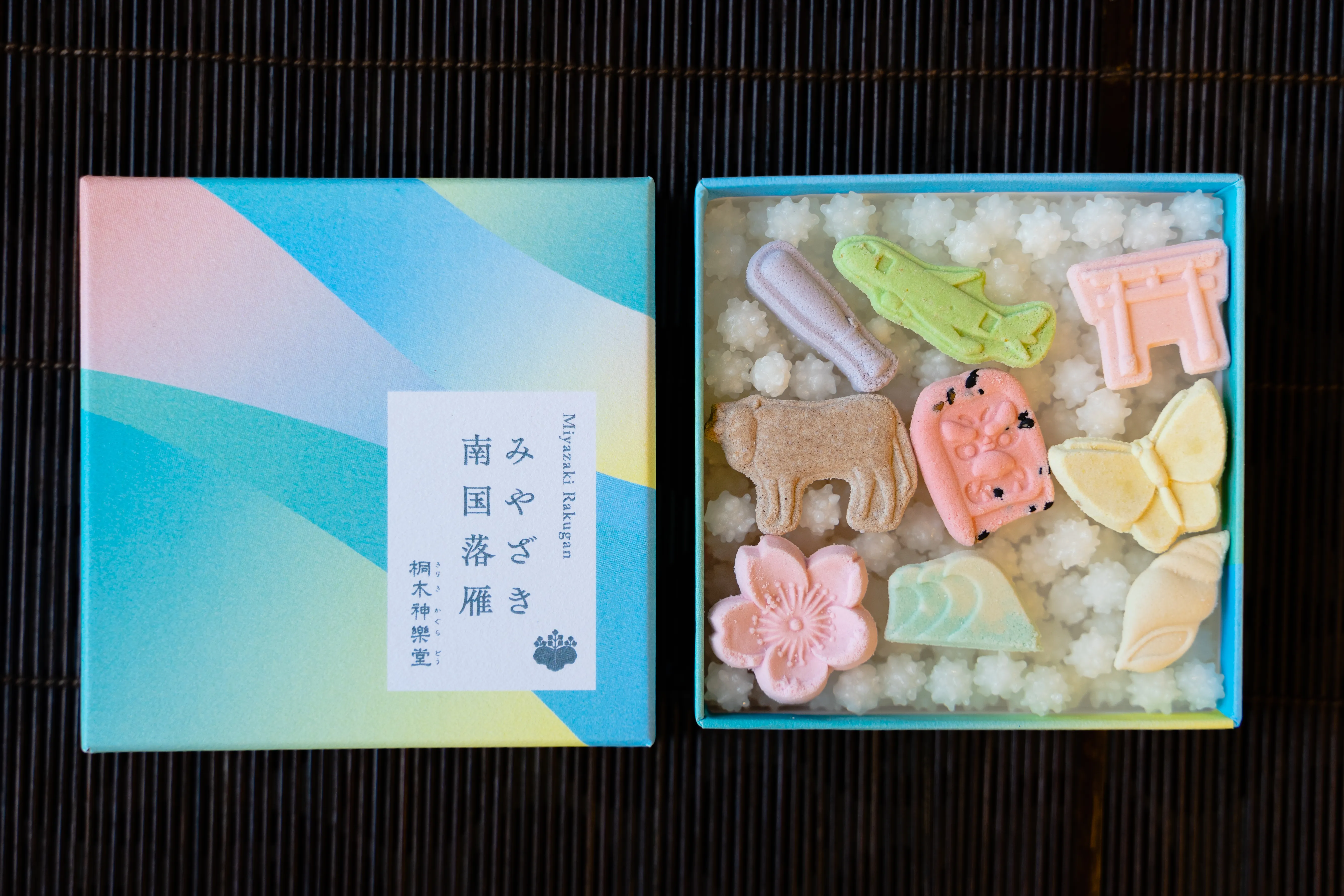
“Miyazaki Nangoku Rakugan” is a dried confection crafted by blending rice flour with wasanbon (和三盆) sugar, shaping it into various forms that depict famous landmarks and specialties of Miyazaki, and then drying it. It boasts a smooth, elegant texture that melts in your mouth. Beyond its simple wasanbon flavor, it offers a delightful variety including black sesame, locally sourced ginger, Hyuganatsu citrus, and cocoa flavors to savor.
Mr. Kiriki says, “We emphasize not only the deliciousness and appearance of our sweets but also pay attention to the packaging. In Japan, sweets can symbolize greetings and play a crucial role in connecting people. We’re always thinking about how we can connect people through our products.”
Their sweets crafted with meticulous attention to detail, alongside the maker’s heartfelt intentions, will surely warm the hearts of those who receive them.
Locations:
1-12-7 Tachibanadori Higashi, Miyazaki City
Payment Methods:
Cash and credit cards.
For more information, visit their websites below.
Officaial Website: https://www.kiriki-k.com/
To explore the sweets shops in the city, it’s convenient to utilize the “GRUPPI” bus that connects Miyazaki Station with downtown. The cute yellow or orange GRUPPI buses circulate the city center at intervals of about 12 minutes starting around 10:30 AM. You can hop on board for just 100 yen per ride, payable in cash or with a transportation IC card. Be sure to make the most of it!
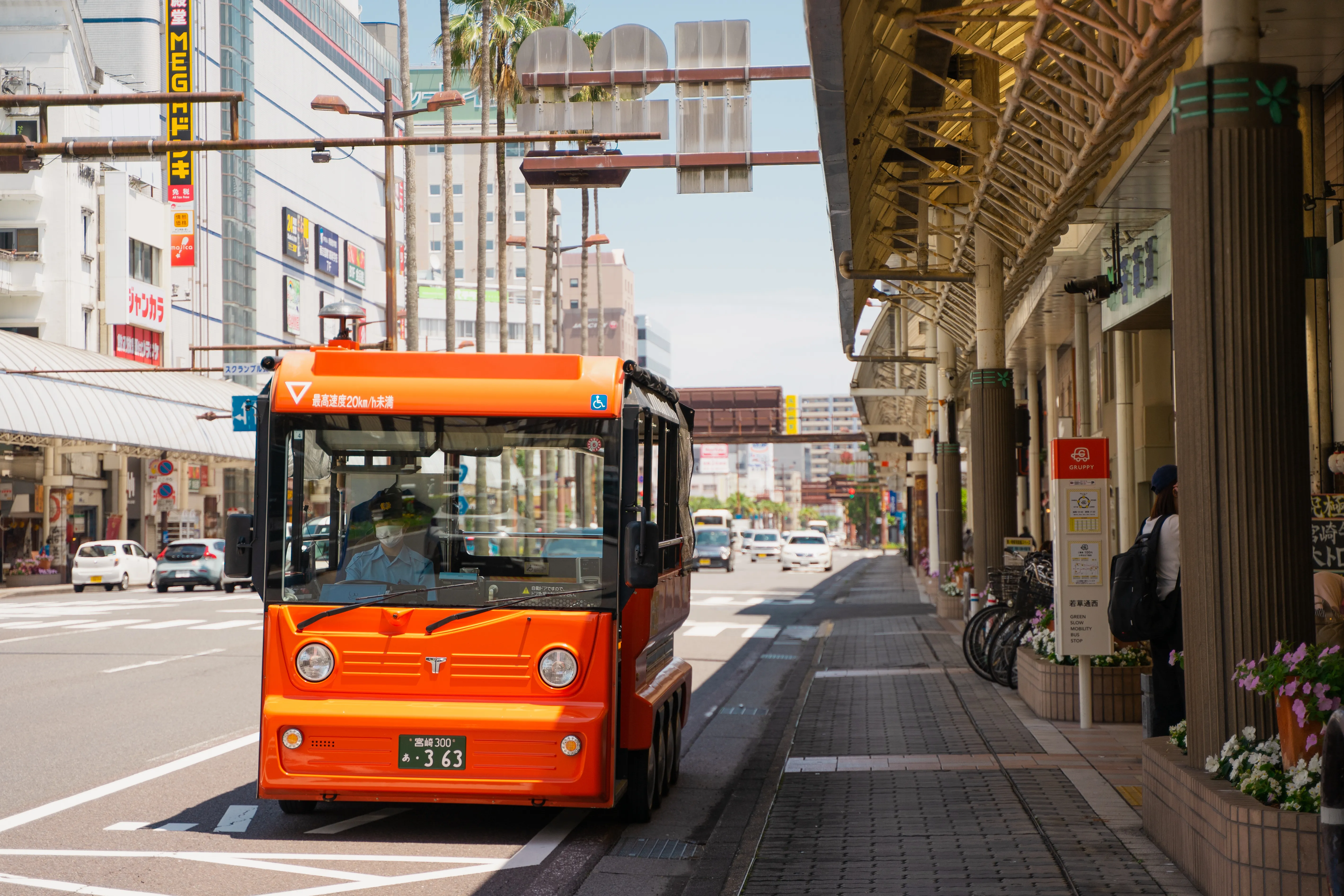
For detailed information about boarding locations and schedules, please check the following website:
